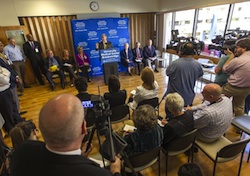The Seton Healthcare Family’s announcement Tuesday to open the region’s first psychiatric emergency department raises a simple question: How has Austin gotten by for so long without one? The answer is equally simple: Not very well.
A patient in an acute psychiatric crisis needs a medical assessment that often requires laboratory or imaging studies to rule out other physical contributing factors. That’s fundamental, and it’s why urban areas have psychiatric emergency services within acute care hospitals. Up to now, Austin has turned a blind eye to that basic standard of care.
Here’s the sequence of events that led to where we are:
1861 The Texas State Lunatic Asylum opened, 152 years ago. In 1925, the name changed to Austin State Hospital, perhaps signaling that it was ours. But the fact is the hospital was established to serve 38 Central Texas counties.
As the Central Texas population grew throughout the 20th century, its hub, Austin, failed to keep pace with needed psych emergency beds, so we “overused” our allotment of state hospital beds.
 Early 2000s County Probate Judge Guy Herman, whose court handles mental health cases, started a petition drive to create a hospital taxing district to better fund and organize health care. Community leader Clarke Heidrick came on board to push the business community. Austin Mayor Kirk Watson, whose leadership style is to bring people together to solve problems, mobilized the community at large. Many of us campaigned hard and talked to the electorate like grown-ups, explaining the need.
Early 2000s County Probate Judge Guy Herman, whose court handles mental health cases, started a petition drive to create a hospital taxing district to better fund and organize health care. Community leader Clarke Heidrick came on board to push the business community. Austin Mayor Kirk Watson, whose leadership style is to bring people together to solve problems, mobilized the community at large. Many of us campaigned hard and talked to the electorate like grown-ups, explaining the need.
2004 Travis county voters responded and voted to tax themselves to create the district. (I love this town.)
2005 Texas Department of State Health Services Commissioner Eduardo Sánchez, MD, called community officials and health care players together in a room to suggest there may be better ways to work together to a) care for Hurricane Katrina victims and b) provide needed, organized behavioral health services.
2006 The president and CEO of the health care district (now Central Health), Trish Young Brown, convened a policy group of mental health stakeholders: Austin and Travis County elected officials, the county probate judge, law enforcement that provides patient transport and health care provider representatives from Seton, St. David’s HealthCare and Austin Travis County Integral Care (formerly Austin Travis County Mental Health Mental Retardation). The group met monthly and still meets today. A separate operations group was formed to smooth out day-to-day transitions in care.
2011 In September, Sen. Watson announced his audacious 10 Goals in 10 Years, which included initiatives such as providing needed psychiatric care and facilities, building a medical school and a modern teaching hospital and establishing modern health clinics.
Later in 2011, the state’s Medicaid 1115 waiver to transform care was approved by the Centers for Medicare and Medicaid Services, thus bringing down significant federal dollars. Central Health administers the waiver and together with Seton developed 30 ambitious projects to improve care, eight of which involve behavioral health, for example, the use of telepsychiatry in emergency departments.
2012 With goals set, health care improvements planned and federal dollars contingent on local contributions, Travis County voters again voted to increase their taxes to support health care, this time for a medical school. (I love this town.)
The new 17-room psych ER at University Medical Center Brackenridge will be staffed by people who are comfortable and competent to care for those in a psychiatric crisis including social workers, case managers, 35 nurses and 10 who can prescribe medication — seven psychiatrists and three advanced practice nurses. It will be a quiet place with an enclosed patio and common room. By 2016, it should serve 10,500 patients per year.
Champagne corks didn’t pop at the press conference, though, as every single speaker — Seton board Vice Chair Sr. Helen Brewer, Sen. Watson, Mayor Lee Leffingwell, Young Brown, Judge Herman and Seton President/CEO Jesús Garza — humbly acknowledged that while this is an incredibly important step forward, Austin still lags far behind other Texas urban areas of our size and that we are nowhere near where we need to be in mental health care.
But hey, let’s not look back. It’s a new day in Austin. We’ve got good leadership, smart voters and lots of talent. On the horizon we’ve got a new psych ER, a medical school, new teaching hospital, new clinics and a federal government that wants to help pay for it. One day, together, we’ll reach the holy grail of health care: people getting the right care in the right setting in the right amount.

 Austin, Texas
Austin, Texas